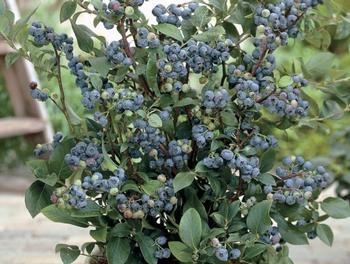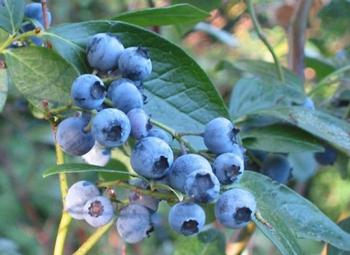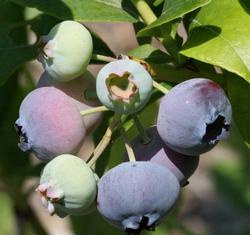Blueberries: healthy, tasty, and pretty
-
The story of the blueberry is a striking example of how new fruits and improved varieties come to the market. Blueberries were found only in the wild until around 1940 when a New Jersey breeder, Elizabeth Coleman White, and botanist Dr. Frederick Coville started to develop improved blueberry varieties with fruit four times the size of wild berries. Today, growers persist in developing cultivars with bigger berries, earlier fruiting times, and hardier bushes.
 Southern high-bush blueberry (Vaccinium corymbosum). Photo courtesy of Gardensoft
Southern high-bush blueberry (Vaccinium corymbosum). Photo courtesy of GardensoftBlueberries are members of the Ericaceae family, along with rhododendrons, azaleas, cranberries, and huckleberries. Blueberries belong to the genus Vaccinium. There are three main types of blueberries grown in the United States; the high-bush, the low-bush and the rabbit-eye.
All types are self-pollinating, but bumblebees and wind help them along. All blueberry plants will cross-pollinate with each other resulting in larger fruit.
Low-winter chill species
East Coast blueberries require more than 800 hours chilling to break dormancy and produce fruit. They grow best in the northeastern United States, however, Southern breeders have developed low-chill varieties in the past 50 years that require very little chilling, and these varieties grow successfully in California climates.
Southern high-bush blueberry cultivars best for Marin County
The southern high-bush blueberry, Vaccinium corymbosum, is a vigorous plant that grows well in our Marin coastal climate.- Hybridized for superior fruit, soil adaptability, heat tolerance, and low winter-chill requirements
- Berries ripen as early as late April/early May
- Self pollinating; planting two varieties together results in larger berries
- Some recommended high-bush varieties are: Blanden, Bluecrisp, Bountiful Blue, Emerald, Huckleberry, Jewel, Jubilee, Misty, O’Neal, Sapphire, Sharpblue, Snowchaser, Star, Southmoon, Sunshine Blue
During the growing season, the production of berries occurs over time and berries are classified as early, midseason, and late producers. The blueberry plant begins to bear at about three years and continues for up to 40 years. While ripening fruit turns blue, the fruit is only ready to eat one to two weeks later, when the berry twists off the stem easily and tastes sweet. Southern high-bush blueberry. Photo courtesy of Gardensoft
Southern high-bush blueberry. Photo courtesy of GardensoftHow to successfully grow blueberries
Blueberries require six to eight hours of direct summer sunlight, so make sure you pick a nice sunny spot for planting. Plant healthy two to three-year-old plants in the fall through early spring; plant bare root plants in late winter. Space plants two to three-feet apart in a row, and eight to ten-feet apart between rows.Planting
To plant a blueberry, dig a hole one foot deep and twice as wide. Keep the plant high to improve drainage, spread the roots in all directions, and cover them with a couple of inches of soil.Water your newly planted blueberry plants thoroughly. Blueberries have shallow roots that don’t like to be disturbed. Add a layer of mulch to help protect the roots, and keep weeds and other plants away from the base. Using a pine needle mulch will also help maintain pH levels in addition to protecting the roots.
Because blueberries require good drainage, they do well on slopes, in containers, or in raised beds.
Fertilizing
Blueberries are an acid-loving plant; about a month after planting apply a 10-10-10 fertilizer (about one and a half tablespoons per plant). If you prefer organic-based fertilizers, apply one pound of fish or blood meal per plant. A thrifty way to add an acidifying agent is to incorporate your coffee grounds and tea leaves into the soil around the blueberry plants.Blueberries are heavy feeders and like an application of fertilizer in early spring. Continue feeding every two months until berry season is complete. Watering is most important when the berries begin to swell. Apply one inch of water per week. For drip systems, this is about 1.25 gallons per week. You may have to water four to five times per week during very warm weather.
Pruning
Pruning will result in larger berries. Remember the fruit is produced on one-year-old wood. Prune twiggy, spindly older wood, keeping the bush open. You can tell the difference between a fruit bud and a vegetative bud by their fatter, less pointed appearance. Growers recommend limiting the number of canes to 6 to 8 per bush.Pests
Birds are likely to be your biggest pest. You may want to plant enough to share or use bird netting to discourage foraging. Insect pests are infrequent but may include: aphids and orange tortrix caterpillars (that feed on leaves but do little other damage), root weevils (that may stunt the plant), and thrips (that feed on the developing fruit, leaving a scar).You can help control aphids and caterpillars with a strong spray of water periodically. Dusting off plants with water will also help control thrips. Hanging bright yellow sticky traps in or near host plants also will help control insect pests.
Diseases
Blueberries are generally vigorous plants and are affected by only a few diseases. Botrytis twig and blossom blight cause a gray mold fungus, which can be controlled by spraying during wet weather with a copper fungicide every ten days from petal fall. Phytophthora root rot can occur with overwatering or poor drainage. Ripening blueberries. Photo courtesy of Gardensoft
Ripening blueberries. Photo courtesy of Gardensoft
Blueberry plants also add visually to your landscape
Edible landscaping with blueberries is rewarding visually, in addition to the production of healthy and tasty berries. Blueberries have lovely, glossy green foliage that turns scarlet and yellow in the fall. In spring, clusters of small white flowers turn to berries from May through July.Homegrown fruit is always tastier than store-bought, and blueberries are loaded with powerful disease-fighting antioxidants.
Original article by Anne-Marie Walker
Edited for the Leaflet by Lisa MacCubbin



